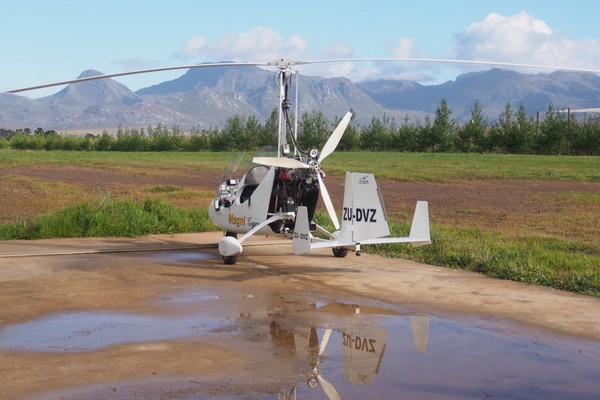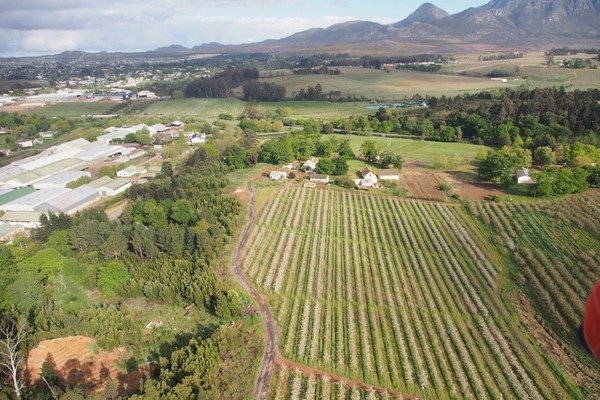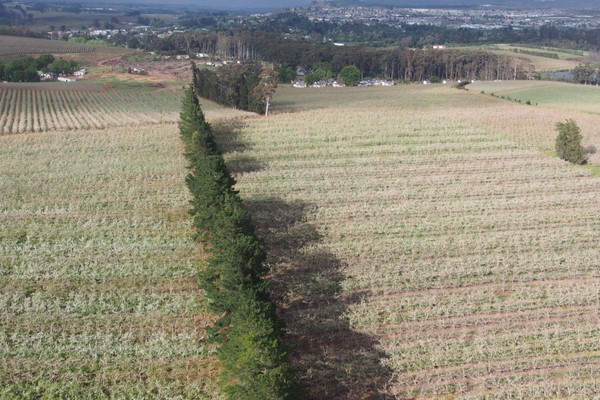Latest column from Jamie Goode
I was visiting the Elgin wine region, where I was due to be taking part in the Chardonnay Symposium. My hosts, Brian and Marion Smith of biodynamic winery Elgin Ridge, had arranged a treat for me: a flight across the valley in a light aircraft. But there turned out to be a problem. The pilot had sold his plane, and thus was planeless. But Brian had another plan. One of the growers in the valley, Ian Corder of Corder Wines, had a gyrocopter. Ian, Brian and I just happened to be tasting together at Almenkerk, and Brian asked Ian, ‘could you take Jamie up?’ So it turned out that the next morning I headed over to small landing strip on Oak Valley’s farm, where Ian was preparing his gyrocopter for the flight.
I don’t know if you know what a gyrocopter looks like. I didn’t when I agreed to fly. Arriving at the landing strip I now saw exactly what a gyrocopter looks like. First, it’s tiny and flimsy-looking. It has what looks like a lawnmower engine, which drives a rear-facing propeller. And there’s also an unpowered, two blade rotor. How on earth is this thing supposed to fly? It has no wings, and the rotor is unpowered. This felt a bit scary, but I got in, and I can confirm that a gyrocopter, by some miraculous means, can fly, because after a short run down the strip, it took off and began to climb.

So, Elgin from the air. It’s a really good way of getting to grips with a wine region. We flew for 40 minutes, all around, then out of the valley to the coast, and back in again. It was tremendous fun, but I was really happy when we landed safely.
Elgin is technically a valley, but it doesn’t look like one at all. The best way to think of it is as a saucer (I have Richard Kershaw to thank for this description): it’s an elevated plateau, rimmed by mountains. It’s actually the only wine region in South Africa completely surrounded by mountains. There are just four roads into the valley, and all of them are passes. The mountains that form the rim of the saucer are made of Table Mountain sandstone, while inside the valley the soils are mostly decomposed shale.

Within the valley, there are all sorts of exposures: lots of little hills, and not so much completely flat ground. This makes for a range of microclimates, and so deciding where to put a vineyard and what to grow is a complex choice. It’s also the coolest of South Africa’s wine regions. The coast is pretty close: at Iona, which is perched on the crest of a hill, you can see the sea from some parts of the property. When people first started planting vines here, they didn’t think it would be possible to ripen reds, and Sauvignon Blanc was the great hope. Since then, it’s become clear that quite a few varieties do well here: you just need to plant them in the right places.
From the air, you can see that there aren’t all that many vineyards in the valley. It’s actually an apple growing district with vineyards rather than a wine region. The region was first officially delineated as a ‘Ward’ within the District of Overberg as recently as 1990. At this time, apple growing was going through a bad time, so as well as pioneering wineries, lots of farmers planted vineyards because they thought it was a way to make money. Things have changed, and now apple growing is vastly more profitable than farming grapes. So quite a few vineyards have been ripped out and replanted with apples. There are 7000 hectares of farming land in the valley, with 6000 hectares of orchards (mostly apples, some pears), which at the moment are making good money. There are just 800 hectares of vineyards, down from a high a few years ago of 1000, with vines disappearing every year. ‘If we weren’t passionate about what we do, we’d just rip out vines and plant orchards,’ says Joris van Almenkerk of Almenkerk, one of the leading wineries in the valley. He points out that while there are 28 producers making Elgin wines, there are only 9 cellars in Elgin. A lot of the grapes leave the valley. Almenkerk has 15 hectares of vineyards, plus four more of apples and pears, and they’ve just planted some more apples.

Oak Valley, one of the largest farms in the valley, has 360 hectares of apples and are busy planting more. ‘They say money doesn’t grow on trees,’ says Oak Valley’s Brad Gold, ‘but here it does.’ He adds, ‘if you are just selling grapes, you are better off planting apples.’
Paul Cluver, whose family winery was one of the pioneers of Elgin winegrowing, agrees that Elgin is currently in a state of flux. The second largest grape grower in the valley, Malteno (with their brand Winters Drift) has moved away from vines. ‘They took a position and ripped out 60 hectares of vines,’ he says.
Still, there’s plenty of optimism about the wines that are coming out of Elgin these days, economic issues concerning the profitability of grapes aside. Chardonnay, in particular, is causing quite a buzz, hence the Chardonnay Symposium, which was well attended. Richard Kershaw, a relative newcomer, is leading the way. His most recent releases are a three-pack of stunning Elgin Chardonnays titled ‘Deconstructed’, from different clones and soils. They retail at 2400 Rand, which is an unprecedented price for South African Chardonnay. The good news is that wines like these will, by virtue of their pricing and market positioning, raise the price ceiling and prestige of Elgin Chardonnay. The result will be that some of the current excellent Chardonnays from the Valley, which are underpriced, will be able to sell for a bit more. This should ensure the future of vines in Elgin, and stop the vineyards being ripped out for orchards. Because this is a very good place indeed to grow wine grapes.
Aside from Chardonnay, Elgin is making some impressive Sauvignon Blanc (the most widely planted variety in the valley), and smart Pinot Noir and Syrah. There’s also some very nice MCC (sparkling wine) emerging, with Charles Fox specializing entirely on MCC production. I have the feeling that we are yet to see exactly what this small wine valley can produce.
-Jamie Goode